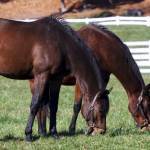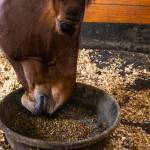Managing Horses on High-Fructan Pastures

Grass…sweet, fresh, appetizing…it seems like the perfect feedstuff for horses. Indeed, it’s hard to find a horse, even a picky eater, that won’t dig right in when given access to pasture. So how can this readily available, appealing, natural forage be dangerous for some horses and ponies? A closer look provides an answer: it’s not the grass itself, but the amount of a specific type of sugar within the plants, that’s the problem.
Fructans are specially adapted sugars that are found in cool-season forages. These sugars derive their unique properties from the bonds that hold individual fructose sugars together to form short- and long-chain carbohydrates. These bonds cannot be broken down by normal enzymatic mechanisms that digest soluble sugars in the stomach and small intestine. For this reason, these easily fermented sugars pass into the hindgut, a situation that leads to rapid production of lactic acid and volatile fatty acids (VFAs). VFAs are the normal products of the digestion of cellulose and other cell wall constituents of forages, so horses handle them well. Lactic acid, however, is neither efficiently used by other bacteria nor handily absorbed from the hindgut. The resulting accumulation of lactic acid in the hindgut is a cause of colic and laminitis in horses on pasture.
All horses are subject to digestive upsets associated with lush spring pasture. The content of highly fermentable carbohydrates in lush pasture can be overwhelming to the unadapted digestive system. Ponies, because of a “thrifty” gene that allows them to survive on little more than limited amounts of medium-quality forages, and overweight horses, because of insulin resistance and associated high levels of circulating pro-inflammatory agents, are particularly susceptible to pastures with high fructan contents. However, many horses are able to handle some amount of pasture turnout if their digestive tracts are allowed time to adapt to the dietary change and if a hindgut buffer is used to help neutralize lactic acid.
Fructans are produced by photosynthesis. Photosynthesis occurs in the leaves during daylight hours; the sunnier the day, the more photosynthesis, and therefore the more fructans. During the dark (overnight) phase of photosynthesis, plants use the sugars to grow more leaves and stems. Extra sugars that are not used for growth are store within the plant tissues. Many cool-season grasses store fructans in the lower two inches of the stem just above the soil line. However, temperatures at night are critical. If the temperature is not above 40° F (4° C) at night, the plant will not grow and sugars remain in the leaves in high concentrations.
So, when is the best time to graze horses in order to avoid fructans? The answer to this complicated question is, “It depends.” One thing to consider is the daily cycle of high and low fructan levels. During seasons of warm days and cool nights (below 40° F or 4° C), sensitive horses should not be allowed to graze at all, and grazing time should be limited for all horses. If the weather is sunny during the day and it stays warm at night, horses should be grazed early in the morning when plants have had the night hours to use up sugars from the day before. They should be taken off the pastures before the day gets hot and sugar production starts all over again.
Another factor to take into account is the ongoing lifecycle of grasses. When grasses begin to grow in the spring, the first 3 to 6 inches of growth have very low levels of fructans. But the caution flag must go up: while fructans may be low during early pasture growth, the amounts of indigestible cellulose and lignin are also very low. Horses tend to eat large amounts of this appetizing new grass. In mature forages (plants above 8 to 10 inches that are going to seed), levels of fructans, cellulose, and lignin are higher, and the high cellulose and lignin levels tend to decrease intake. Whether horses eat smaller amounts of the less-appealing mature grass or larger amounts of the immature grass, fructan intake may total about the same for both scenarios.
Pastures should be managed so that horses do not overgraze. In pastures that have been heavily grazed, horses may have no choice but to consume the lower two inches of pasture plants where fructans are stored. However, horses tend to be selective when grazing and often choose to eat pasture plants with the highest fructan levels, even when a variety of forage is available.
In addition, environmental pasture stress can cause fructan levels to increase. In plants reacting to drought or frost, fructan levels can rise by as much as 30%.
As a general rule, horses that have high energy requirements can handle fructans as long as overall energy balance is taken into consideration. The classes of horses that can generally handle high fructan levels if they are allowed time to adapt to them gradually include growing horses (just don’t overfeed grain when fructans are high), lactating mares, hard-working horses, thin horses (that are not compromised by disease or parasites), and breeds that are known to be hard keepers, such as Thoroughbreds. Those that should generally avoid fructans are easy keepers, ponies, and any overweight horses. However, each horse is an individual, regardless of breed. Keep a close eye on all pastured horses, and check often for signs of colic or laminitis.
The fructan question can be complex and confusing. When in doubt, use grazing muzzles if limiting intake is necessary; start with brief turnout periods and increase gradually when introducing horses to grass; immediately consult your veterinarian for guidance if you find signs of colic or laminitis; and keep sensitive horses off pasture completely. Use of a product such as EquiShure, a time-released hindgut buffer, is helpful in preventing metabolic problems associated with overconsumption of sugar-rich grasses.
Research supports the use of a hindgut buffer in cases of high grain and high fructan intake. Hindgut acidosis is characterized by a drop in pH caused by microbial fermentation of starches and sugars, such as fructans, and the resulting accumulation of excessive lactic acid in the hindgut. EquiShure is appropriate for all horses at risk of suffering from subclinical acidosis. Learn more.








